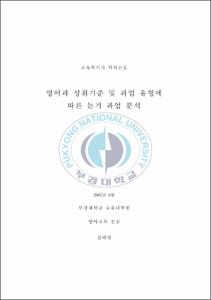영어과 성취기준 및 과업 유형에 따른 듣기 과업 분석
- Alternative Title
- An Analysis of ListeningTasks in Middle School English Textbooks Based on Achievement Standards And Types of Listening tasks
- Abstract
- The purpose of this study is to analyze how well the goals of the seventh revised curriculum's listening tasks have been realized and how diverse and suitable the tasks are in middle school English textbooks for first, second and third graders.
For this purpose, three types of middle school English textbooks for first, second and third graders were randomly selected out of a range of 13 textbooks, with a total of nine middle school English textbooks analyzed. The textbooks were analyzed based on the following criteria: achievement standards in the 7th national curriculum and types of listening tasks as described by Ur (1984).
The results of this study can be summarized as follows. First, according to the analysis based on achievement standards in the 7th national curriculum, the listening tasks in the textbooks don't reflect standards for achievement with the necessary proficiency level for each grade. The 7th achievement level, which is for first graders, has the highest proportion of listening tasks of all the textbooks, regardless of the learners' proficiency level. For example, and most especially, the listening task items in the 9th achievement level have a 0% rating - having no appropriately adapted listening tasks in the textbooks.
Second, according to the analysis based on the listening task types of Ur (1984), between "listening for perception" and "listening for comprehension", "listening for comprehension" is more useful for actual communicative situations. This listening task type was present in greater proportions in all of the textbooks, regardless of the proficiency level.
Third, among the listening task types of Ur, "listening for perception" can be sub-categorized as "at word-level practice" and "at sentence-level practice". Between these two, "at sentence-level practice" - which is at a higher level than "at word-level practice" was present in greater proportions in all textbooks, regardless of grade.
Fourth, there are four subcategories in the listening task type "listening for comprehension". Among these subcategories, "listening and making shorter responses" was present in greater proportions in all the textbooks regardless of the learner's proficiency levels. With this in mind, we noticed that listening tasks in the textbooks tended to be very biased. We noted very few uses of "listening for research and discussion", which requires high fluency levels and is the most important means of listening for learning. The listening tasks in the textbooks were biased towards two subcategories in "listening for comprehension": "ticking off the items" and "altering or marking maps, ground-plans, graphs, grids, family trees". Clearly listening tasks in these textbooks were not diverse enough to motivate learners.
Based on the above findings, we provided the following suggestions on how to improve the listening sections of middle school textbooks. First, the level of listening tasks in the textbooks needs to be balanced. Above all, higher level listening tasks are necessary for more advanced learners.
Second, the types of listening tasks need to be more diverse in order to make learners feel more interested and motivated to study hard.
Third, the textbooks should offer more interactive listening tasks to motivate learners to actively participate. As the 7th revised curriculum puts emphasis on learning in small groups, some of Ur's task types, such as "listening for research and discussion", should be placed into textbooks with greater regularity.
- Issued Date
- 2007
- Awarded Date
- 2007. 8
- Type
- Dissertation
- Publisher
- 부경대학교 교육대학원
- Alternative Author(s)
- Kim, Hye-Young
- Affiliation
- 부경대학교 교육대학원
- Department
- 교육대학원 영어교육전공
- Advisor
- 조윤경
- Table Of Contents
- Ⅰ. 서론 = 1
1.1. 연구의 필요성과 목적 = 1
1.2. 연구 과제 = 2
1.3. 연구의 제한점 = 3
Ⅱ. 이론적 배경 = 4
2.1. 듣기 = 4
2.1.1. 듣기의 정의 = 4
2.1.2. 듣기의 필요성과 이해 과정 = 5
2.2. 듣기 과업 = 7
2.2.1. 과업의 정의 = 7
2.2.2. 듣기 과업의 중요성 및 특성 = 9
2.2.3. 듣기 과업 분류 = 12
2.3. 중학교 영어과 7차 교육과정과 성취 기준 = 14
2.3.1. 중학교 영어과 7차 교육과정의 특성 = 14
2.3.2. 중학교 영어과 7차 교육과정 성취기준 = 15
2.4. 선행 연구 분석 = 17
Ⅲ. 연구방법 = 22
3.1. 분석 대상 = 22
3.2. 분석 기준 = 26
Ⅳ. 분석 결과 및 논의 = 28
4.1. 성취기준에 따른 듣기과업 분석 = 28
4.1.1. A 교과서 듣기과업 분석 = 28
4.1.2. B 교과서 듣기과업 분석 = 31
4.1.3. C 교과서 듣기과업 분석 = 34
4.2. Ur(1984)의 과업 분류에 따른 듣기 과업 분석 = 38
4.2.1. A 교과서 듣기 과업 분석 = 38
4.2.2. B 교과서 듣기 과업 분석 = 43
4.2.3. C 교과서 듣기 과업 분석 = 47
4.3 분석결과 요약 및 논의 = 51
4.3.1. 성취 기준에 따른 듣기 과업 분석 결과 = 51
4.3.2. Ur(1984)의 과업 분류에 따른 듣기 과업 분석 결과 = 54
Ⅴ.결론 및 제언 = 60
5.1 결론 = 60
5.2 제언 = 62
참고 문헌 = 64
부록 = 68
- Degree
- Master
- Files in This Item:
-
-
Download
 영어과 성취기준 및 과업 유형에 따른 듣기 과업 분석.pdf
기타 데이터 / 820.6 kB / Adobe PDF
영어과 성취기준 및 과업 유형에 따른 듣기 과업 분석.pdf
기타 데이터 / 820.6 kB / Adobe PDF
-
Items in Repository are protected by copyright, with all rights reserved, unless otherwise indicated.